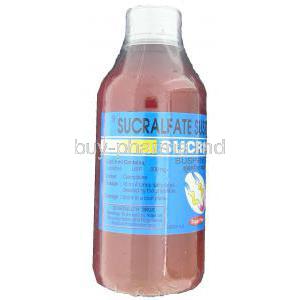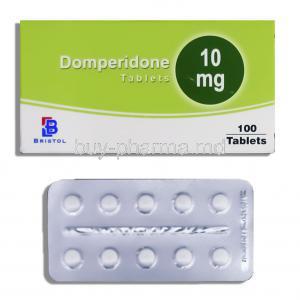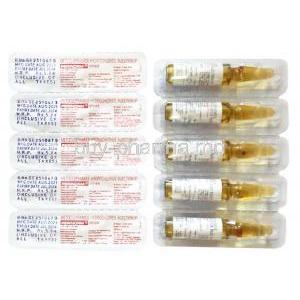Sucralfate Suspension
- I. Introduction to Sucralfate Suspension
- II. Composition of Sucralfate Suspension
- III. How Sucralfate Works
- IV. Uses of Sucralfate Suspension
- V. Off-Label Uses of Sucralfate
- VI. Dosage and Administration
- VII. Administration Details
- VIII. Special Considerations in Administration
- IX. Side Effects of Sucralfate Suspension
- X. Important Precautions and Warnings
- XI. Interactions with Other Medications
- XII. Handling and Storage of Sucralfate Suspension
- XIII. Overdosage Information
- XIV. Contraindications for Sucralfate Suspension
- XV. Careful Administration Practices
I. Introduction to Sucralfate Suspension
Overview and Importance of Sucralfate in Gastrointestinal Treatment
Sucralfate Suspension is a treatment for gastrointestinal issues working to create a protective barrier, over stomach and intestinal ulcers. This helps speed up the healing process and relieve symptoms effectively.
Brief History of Sucralfate Development and Usage
Sucralfate, which was first introduced in the 1960s was originally employed for addressing peptic ulcer ailment. Since then its usage has broadened, highlighting its effectiveness and documented safety record through various clinical studies over the years.
II. Composition of Sucralfate Suspension
Active Ingredients and Their Roles
Sucralfate Suspension contains sucralfate, as its active ingredient, which is a mix of sulfated polysaccharide and aluminum hydroxide. This combination forms a barrier at ulcer sites, shielding them from acid and enzymes, thus supporting the body's natural healing processes.

Formulation Details and Characteristics
This suspension has been specially designed to improve its adherence to the membranes. It contains additional substances that boost its stability and taste, guaranteeing that the medicine stays potent and easy to use.
Sucralfate and oxetacaine suspension
Sucralfate combined with Oxetacaine consists of two medications:
Sucralfate and Oxetacaine, also known as Oxethazaine.
- Sucralfate is used to treat ulcers by shielding the injured ulcer tissue in the stomach from acid or damage, aiding in the healing process.
- Oxetacaine, an anesthetic offers quick pain relief for ulcers or acidic stomach injuries through its numbing properties.
III. How Sucralfate Works
Mechanism of Action in the Gastrointestinal Tract
Sucralfate works by attaching to the base of the ulcer creating a protective barrier similar to a gel that shields it from harm caused by stomach acid, pepsin and bile salts. This barrier not shields the ulcer from additional erosion but also helps enhance the presence of growth factors and bicarbonates creating an ideal environment, for healing.
Protective Barrier Formation and Healing Promotion
When given, sucralfate quickly combines with stomach acid to create a sticky material that attaches specifically to areas with ulcers. This forms a barrier isolating the ulcer from harmful substances and speeding up the healing process.
How quickly does sucralfate work?
Sucralfate, also known as Carafate begins to take effect within 1 to 2 hours of ingestion. However it may require weeks or even months of consistent daily use, for the ulcer to fully heal.
IV. Uses of Sucralfate Suspension
Primary Indications: Peptic Ulcer Disease
Other Therapeutic Uses in Gastrointestinal Disorders
- Gastritis and esophagitis; It has an effect on irritated mucous membranes.
- Preventing stress ulcers; Particularly beneficial for ill patients to avoid stomach bleeding.
- Treating GERD; While not the primary choice it can be beneficial, in situations where standard treatment's ineffective.
sucralfate for gastritis
V. Off-Label Uses of Sucralfate
Expanded Applications in Gastrointestinal Care
Clinical Studies and Evidences Supporting Off-Label Use
Recent research has shed light on the potential of Sucralfate in treating a range of conditions beyond its applications. This includes its effectiveness in managing chemotherapy induced mucositis. As a preventive measure, for post endoscopic procedures.
VI. Dosage and Administration
Standard Dosage Recommendations
Sucralfate Suspension is usually taken in a 1 gram dose, four times daily on a stomach. One hour before meals and before bedtime. This dosing schedule is designed to optimize its pharmacokinetics, for treatment results.

Adjustments for Specific Conditions and Patient Groups
Patients with levels of kidney function or in various physiological conditions like pregnancy may require changes, in the dosage.
Sucralfate suspension for dogs dosage
The usual amount given to pets is usually between 1/4 and 1 gram. Small dogs and cats are frequently given 1/4 to 1/2 gram every six to eight hours.
VII. Administration Details
Methods for Proper Administration of Sucralfate Suspension
Before using Sucralfate Suspension make sure to shake it to ensure that the medication is evenly spread throughout the suspension, for maximum effectiveness.
Timing and Dietary Considerations
For results, make sure to take this medication on an empty stomach so it can stick better to the ulcer areas. Remember not to use any antacids within half an hour after taking Sucralfate to avoid affecting how it works.
Can you drink water after taking sucralfate suspension?
Make sure to wait for least 30 minutes after consuming sucralfate before having any drinks. When using the form of Carafate be sure to shake it thoroughly before measuring and taking a dose to ensure that the medication is evenly distributed. Remember not to dissolve tablets, in water; they are meant to be taken whole.
How do you take sucralfate 4 times a day?
The typical dosage for treating ulcers is to take the medication four times a day on an empty stomach (at least one hour before meals and at bedtime). Follow your doctors instructions. Keep taking it for the period or, until an x ray or endoscopy shows that the ulcer has healed.
What happens if you take sucralfate with food?
When you've eaten sucralfate may not effectively cover your ulcers to aid in their healing. The solution is straightforward; Take sucralfate when your stomach is empty either an hour before or two hours after a meal.
VIII. Special Considerations in Administration
Administration to Elderly Patients
As people get older they might react strongly to sucralfate so it's important to adjust the dosage carefully and keep a close eye on it. With age kidney function tends to decline which can impact how the drug is removed from the body. This calls for customized treatment plans to minimize any side effects.
Administration to Pregnant Women and Nursing Mothers
During pregnancy, sucralfate is generally deemed safe for use. It should only be taken if absolutely necessary due to the lack of conclusive studies on its effects on pregnant women. For breastfeeding mothers it is advisable to proceed with caution as the transmission of this medication into breast milk and its impact, on health remain uncertain.
Administration to Children: Safety and Dosage Adjustments
Sucralfate is not commonly prescribed for children due, to the need to adjust the dosage according to their body weight and surface area closely monitor its effectiveness and potential side effects and make adjustments based on the childs ability to take the suspension.
IX. Side Effects of Sucralfate Suspension
Overview of Common and Rare Side Effects
Sucralfate is usually well received by people although some individuals might encounter mild digestive issues like constipation, which happens to be the side effect that is most frequently mentioned. In cases more serious responses such, as hypersensitivity and intense constipation could potentially arise.
Management of Side Effects
To effectively manage side effects it is important to:
- Modify the dosage to reduce any discomfort.
- Make changes to address constipation.
- Seek advice from healthcare professionals for persistent or severe symptoms.
X. Important Precautions and Warnings
Conditions and Patient Histories Requiring Caution
Patients who have existing kidney issues or past reactions to sucralfate ingredients should take this medicine under close medical monitoring.

Potential Risks and Safety Precautions
Patients should make sure to share all their history with healthcare professionals and follow the prescribed dosages and administration instructions carefully to reduce any potential risks.
XI. Interactions with Other Medications
Common and Significant Drug Interactions
Sucralfate may interact with medications, especially
- antacids and proton pump inhibitors. These could reduce the effectiveness of sucralfate.
- Tetracycline antibiotics: Sucralfate might interfere with their absorption.
How to Manage and Prevent Harmful Interactions
When managing sucralfate it's important to schedule its administration at 2 hours before or after taking other medications to prevent any potential interactions. Regular monitoring and necessary adjustments, by healthcare providers play a role in this process.
XII. Handling and Storage of Sucralfate Suspension
Optimal Storage Conditions to Preserve Efficacy
Be sure to keep suspension in a cool dry place at room temperature away, from sunlight to ensure it stays effective and stable.
Handling Precautions and Stability
Remember to tighten the bottle cap securely and give it a good shake before using it to make sure the liquid inside is well mixed.
XIII. Overdosage Information
Symptoms and Management of Overdosage
Ingesting much sucralfate is uncommon, but it may lead to digestive issues such as worsened constipation. The treatment primarily involves providing relief for symptoms and offering support with a focus, on addressing any imbalances.
Emergency Procedures and Supportive Care
In case of an overdose, it is important to seek medical help. Treatment options may involve stomach pumping and administering fluids to help the body clear the drugs quickly.
XIV. Contraindications for Sucralfate Suspension
Absolute and Relative Contraindications
People who have allergies to any ingredients in the product should avoid using sucralfate. It is also not recommended for individuals with kidney problems because of the potential, for aluminum toxicity.
Conditions and Scenarios Where Sucralfate Should Not Be Used
It is not recommended for patients who are undergoing types of dialysis at the same time as there is a risk of aluminum buildup.
XV. Careful Administration Practices
Guidelines for Ensuring Safe and Effective Use
To make sure that sucralfate suspension is used safely and effectively it's important to follow the doses regularly check how patients are responding and make adjustments, to the treatment as needed.
Monitoring and Follow-up Recommendations
It is advised to have check-ins to monitor how well the healing is going and any potential side effects, along with conducting occasional tests to assess kidney function in order to improve patient results.














